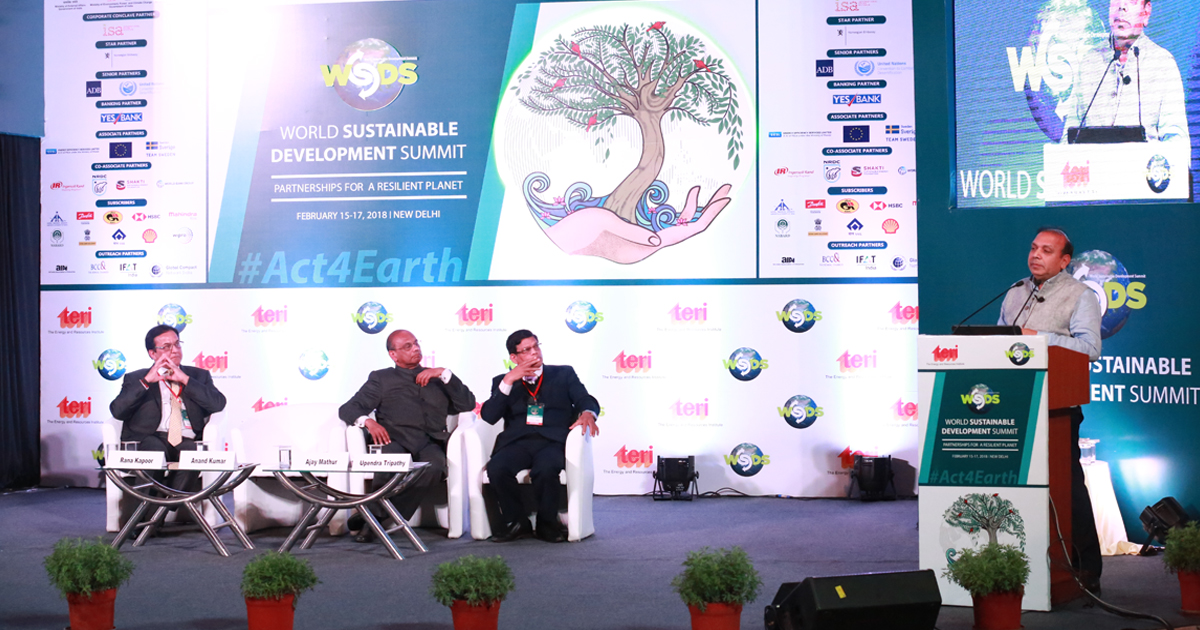
Making the Sun Shine Brighter
 Harnessing the Sun’s potential: Panelists at WSDS2018 call for innovative financing mechanisms, enhanced industry participation to boost solar sector
Harnessing the Sun’s potential: Panelists at WSDS2018 call for innovative financing mechanisms, enhanced industry participation to boost solar sector
An example of innovative entrepreneurship in Bangladesh where a small entrepreneur installs a solar pump on his land to sell water to many farmers in the area, raises an interesting point. Can we take such innovative best practices across borders?
This was among the many issues deliberated at the ongoing WSDS 2018 in New Delhi. The panelists at the inaugural session of the corporate conclave discussed the various aspects of solar energy and the possible ways of harnessing it.
Calling the WSDS a great platform to forge collaborations towards sustainable development, Shri Jayant Sinha, Minister of State for Civil Aviation, said the discussion at the session on solar revolution was ‘particularly timely’. Calling the current age one of acceleration, he said the topics discussed at WSDS around sustainable development exemplify the notion of acceleration.
He said ongoing technological developments should be leveraged to further strengthen the solar sector. He listed internet of things, artificial intelligence, and machine learning which enable distributed power systems, and battery technology among the enablers that are developing at warp speed. Adding that solar revolution is going to be transformational for the society, he said that it was essential for sustainable development.
Dr Ajay Mathur, Director General, TERI, said the fall in the prices of solar power leading to the decarbonization of the electricity sector was not just the light at the end of the tunnel but a luminous search light.
Mr Rana Kapoor, Founder, Managing Director & CEO, YES Bank, said the WSDS was a highly impactful platform as it catalyses strategic interventions with government, academia, and the civil society. Adding that the formation of the International Solar Alliance was a gigantic task, Mr Kapoor said this intergovernmental initiative is now playing a crucial role in the overall development and evolution of solar momentum across the globe.
He shared that YES Bank, which made a commitment of financing 5 GW in 2015, has already financed 4.3 GW so far. While renewable energy has taken off and catalysed rather well in the last few years, there still remains significant untapped opportunity in India.
He suggested that further easing of regulatory measures will enhance the pace of financing for renewable energy in India. Adding that the market today had the depth to underwrite and take credit risk for long-term debt, he suggested matching the tenure of debt with financing long-term projects. Mr Kapoor further suggested innovation through aggregation and securitization of projects.
He said an impetus to retail participation should be given to support renewable energy projects in India.
Mr Upendra Tripathy, Interim Director General, International Solar Alliance, detailed the various initiatives by ISA to accelerate a wholesome development of the solar sector. He said the ISA is trying to get various green finance agencies such as the Green Climate Fund to ensure more money flows in the sector. He added that the International Solar Alliance Summit to be held on March 11, 2018, will be used to launch a few more initiatives in various fields, such as solar mobility and solar rooftops.
Mr Anand Kumar, Secretary, Ministry of New and Renewable Energy, said India was one of the largest markets for renewable energy today. He said the country's rapid strides in the field were driven by its aim to curb carbon intensity of the economy, provide universal energy access to all while ensuring affordability.
Mr Kumar highlighted that both solar and wind power have come at par with conventional thermal power, and also become cheaper in some cases. The tariff for solar power was around INR17 in 2010 which has now come down to INR2.44 today. Mr Kumar added that technological upgradation and research will be of utmost importance for India going forward.